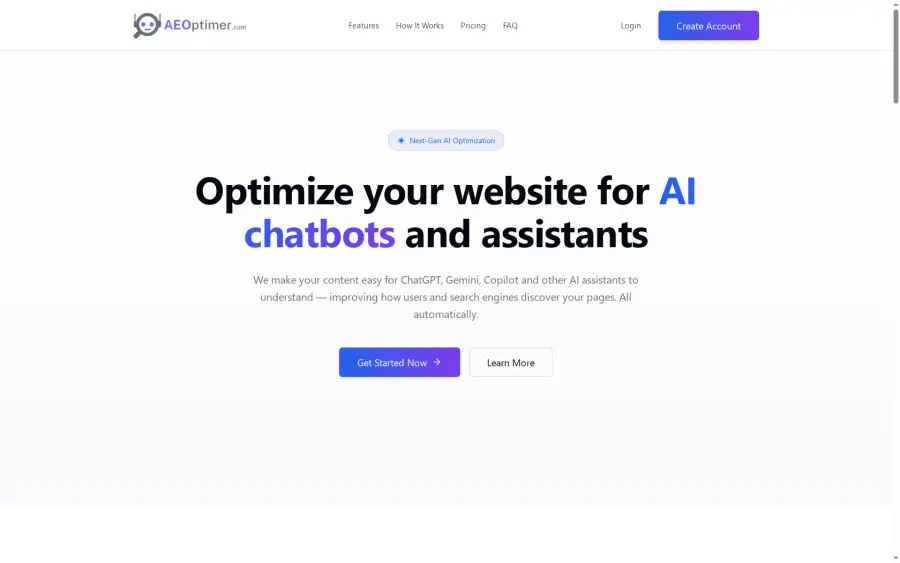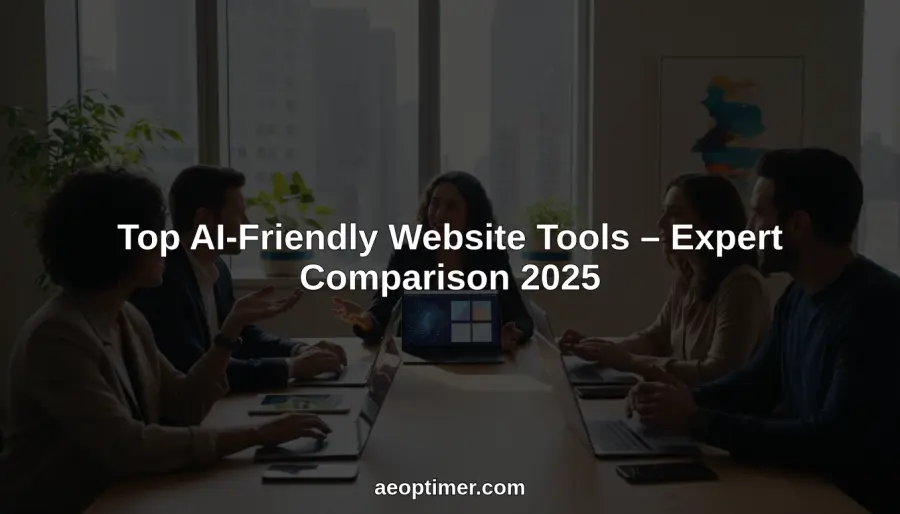Making Websites AI Discoverable: Step-by-Step Guide

Over 60 percent of website traffic now comes through AI-powered search tools and digital assistants. If your content is hard for these systems to find or understand, you risk losing a massive portion of your audience. Websites that meet AI standards enjoy higher visibility and deeper engagement. By following practical steps rooted in expert research, you can open your site to smarter discovery and future-proof your online presence.
Table of Contents
- Step 1: Assess Website Readiness For AI Optimization
- Step 2: Implement Automated AI Visibility Enhancements
- Step 3: Integrate Structured Data And SEO Elements
- Step 4: Enable Monthly Review And AI-Driven Updates
- Step 5: Verify Discoverability With AI Tools
Quick Summary
| Key Point | Explanation |
|---|---|
| 1. Conduct a comprehensive website audit | Create an inventory of all web pages to identify outdated content that may hinder AI discoverability. |
| 2. Implement structured data for clarity | Use Schema.org markup to provide clear context for AI tools, improving content understanding and indexing. |
| 3. Schedule regular content reviews | Establish a monthly review process to keep content fresh and relevant, ensuring it meets AI requirements. |
| 4. Utilize automated tools for optimization | Leverage automated scanning tools to identify and resolve issues that may obstruct AI visibility. |
| 5. Validate AI discoverability with tests | Actively test content across various AI platforms to evaluate interpretation accuracy and identify improvement areas. |
Step 1: Assess website readiness for AI optimization
Prepare to conduct a comprehensive evaluation of your website’s current state and AI optimization potential. This step will help you understand your content landscape and identify key areas for improvement.
According to UC Davis recommendations, your first task is creating a complete inventory of all website pages. Start by mapping out every single page across your digital ecosystem. This audit helps you recognize redundant or outdated content that might hinder AI discoverability.
Begin your assessment with a systematic content review. Open a spreadsheet and list out each webpage. Capture critical details such as page URL, content type, last updated date, and current performance metrics. This granular approach allows you to see your website through an AI assistant’s perspective.
As research from EDUCAUSE suggests, evaluate your digital infrastructure across multiple dimensions. Check your website’s technical capabilities such as structured data implementation, metadata quality, and semantic markup.
Pro Tip: Pay special attention to content clarity. AI tools prefer direct language that communicates information precisely and concisely.
Focus on identifying potential barriers to AI comprehension. Examine your content for complex jargon, unclear sentence structures, and missing contextual information. Your goal is creating a website that AI assistants can easily understand and index.
The next step will involve analyzing your content’s AI friendliness and preparing for strategic optimization techniques.
Step 2: Implement automated AI visibility enhancements
In this crucial step, you will transform your website into an AI discovery powerhouse by implementing strategic automated enhancements that make your content more accessible and intelligible to artificial intelligence tools.
According to HarvardSites, start by focusing on structured content elements. This means crafting descriptive page titles that clearly communicate each page’s core purpose. Write meta descriptions that succinctly summarize page content using natural language AI systems can easily interpret.
Leverage automated scanning tools to identify and resolve potential visibility barriers. UC Davis research recommends using platforms like Siteimprove to perform comprehensive automated scans. These tools can detect issues such as broken links, spelling errors, and formatting inconsistencies that might confuse AI indexing algorithms.
Quick Insight: Automated tools are your silent partners in maintaining a clean AI friendly website ecosystem.
Implement semantic markup and structured data protocols across your website. Use schema.org vocabulary to provide context for AI assistants. This means adding detailed information about your content type page purpose and key information points in a machine readable format.
Focus on creating clean machine readable HTML that presents information logically.
 Remove unnecessary code bloat ensure proper heading hierarchies and maintain consistent content structures that AI tools can easily parse and understand.
Remove unnecessary code bloat ensure proper heading hierarchies and maintain consistent content structures that AI tools can easily parse and understand.
The upcoming step will guide you through advanced techniques for enhancing your website’s AI comprehension capabilities.
Step 3: Integrate structured data and SEO elements
You are about to supercharge your website’s AI discoverability by implementing advanced structured data and intelligent SEO techniques that help artificial intelligence systems understand and index your content more effectively.
According to SEO Daily, start by implementing Schema.org markup across your website. This universal language helps search engines and AI tools comprehend your content context with unprecedented precision. Think of structured data as a translator that converts your website’s complex information into a clear digestible format for AI assistants.
As highlighted by the Web Almanac, structured data serves as a standardized method for sharing information. Begin by identifying the primary content types on your website such as articles products services or events. Then map each content type to its corresponding Schema.org vocabulary.
Pro Tip: Use Google’s Structured Data Testing Tool to validate your markup and ensure proper implementation.
Focus on adding rich detailed attributes that provide comprehensive context. This means going beyond basic information and including nuanced details like author credentials publication dates related topics and content relationships. The more context you provide the easier it becomes for AI systems to accurately index and understand your content.
Prioritize creating clean semantic HTML that complements your structured data strategy. This involves using appropriate heading tags maintaining logical content hierarchies and ensuring your website architecture supports easy AI comprehension.
The next phase will explore advanced techniques for optimizing your content’s AI readiness and enhancing its overall discoverability.
Step 4: Enable monthly review and AI-driven updates
This step transforms your website maintenance strategy into a proactive AI optimization process that keeps your digital content relevant dynamic and consistently discoverable by intelligent search systems.
UC Davis recommends developing a systematic content lifecycle approach. Begin by establishing a monthly review schedule that systematically examines each webpage for accuracy currency and AI compatibility. Create a digital checklist that tracks content performance metrics engagement rates and potential areas requiring updates.
As suggested by HarvardSites, prioritize refreshing key landing pages and critical information sections. Focus on removing outdated content replacing stale statistics and updating references to ensure your website remains a trustworthy source of information for both human readers and AI assistants.
Quick Strategy: Set calendar reminders for your monthly content review to maintain consistency and accountability.
Implement an automated tracking system that monitors content performance signals. Look for indicators such as declining page views reduced user engagement or outdated information timestamps. These metrics will help you identify which sections need immediate attention and optimization.
Consider creating a rotating review schedule where different sections of your website receive detailed examination each month. This approach prevents overwhelming content audits and ensures comprehensive coverage over time. Pay special attention to rapidly changing fields like technology research and industry trends where information becomes obsolete quickly.
Your final step will involve implementing continuous monitoring and refinement strategies to maintain long term AI discoverability.
Step 5: Verify discoverability with AI tools
You have now reached the crucial stage of testing and validating your website’s AI optimization efforts through direct interaction with artificial intelligence platforms and comprehensive verification techniques.
According to UC Davis, the most direct method of verifying AI discoverability is to engage with multiple AI tools actively. Start by searching for your website content across different AI assistants like ChatGPT Gemini and Claude. Ask these platforms to summarize specific pages from your website and carefully analyze how accurately they represent your original content.
Northwestern University emphasizes the importance of critically evaluating AI generated representations. When AI systems discuss your content pay close attention to their accuracy contextual understanding and potential information gaps. Look for precise details that demonstrate whether your optimization efforts have successfully communicated your website’s core messages.
Pro Tip: Test your content across multiple AI platforms to get a comprehensive understanding of its discoverability.
Create a systematic evaluation framework where you document how different AI tools interpret your website content. Track metrics such as information accuracy comprehensiveness and contextual relevance. This approach helps you identify specific areas where your content might need further refinement to improve AI comprehension.
Remember that AI discoverability is an ongoing process. Continuously update your content based on these verification insights. Treat each AI interaction as an opportunity to understand how intelligent systems perceive and process your digital information.
Congratulations you have now completed a comprehensive strategy for making your website AI discoverable and optimized for intelligent search systems.
Here’s a summary of each AI optimization step and its main actions:
| Step | Focus Area | Key Actions |
|---|---|---|
| 1. Assess Readiness | Website audit | Inventory pages Review content Evaluate technical setup |
| 2. Enhance Visibility | Automated tools | Add meta data Fix errors Apply semantic markup |
| 3. Structure & SEO | Structured data & SEO | Use Schema.org Validate markup Add detailed attributes |
| 4. Review & Update | Ongoing maintenance | Schedule reviews Update outdated info Monitor metrics |
| 5. Verify Discoverability | AI interaction & validation | Test on AI tools Analyze summaries Refine content |
Boost Your Website’s AI Discoverability with Automated, Hassle-Free Optimization
Most website owners struggle with keeping up on the complex demands of AI-ready content. The challenge is clear: how do you consistently maintain structured data, semantic markup, and updated content without spending hours on technical audits and manual updates? This guide on making websites AI discoverable highlights the importance of monthly reviews, structured data implementation, and continuous AI-centric enhancements. Yet, executing these steps well can feel overwhelming and time consuming.
This is where aeoptimer.com steps in to simplify your journey. aeoptimer.com is designed specifically for website owners who need automatic AI optimization that runs quietly in the background. With just a simple script added to your site, our platform crawls your content, applies structured data like Schema.org vocabulary, fixes metadata issues, and updates your sitemap monthly—all without changing how your site looks. You get the power of ongoing AI-friendly enhancements and continuous monitoring tailored to evolving search and AI intelligences like ChatGPT and Gemini.

Take control of your website’s future today. Don’t let outdated content or technical barriers hold back your AI visibility. Visit aeoptimer.com now to automate your site’s AI readiness. Start refining your AI discoverability effortlessly and see how easy it is to stay ahead of evolving AI search technology.
Frequently Asked Questions
How do I assess my website’s readiness for AI optimization?
Start by creating a complete inventory of all your website pages, mapping out each URL and capturing details like content type and performance metrics. Conduct a content review to identify outdated or redundant content that may impact AI discoverability.
What automated tools can I use to enhance my website’s visibility for AI?
Utilize automated scanning tools to identify issues like broken links and formatting inconsistencies that could confuse AI indexing. Perform comprehensive scans regularly to maintain a clean and AI-friendly website environment.
How do I implement structured data to boost AI discoverability?
Begin by applying Schema.org markup to your primary content types, which helps AI systems understand your content’s context. Ensure to include rich attributes related to each content type, as this enhances the clarity of your information for AI assistants.
What steps should I take for ongoing content reviews and updates?
Establish a monthly review schedule to assess each webpage’s relevance and accuracy. Focus on refreshing key landing pages and outdated information to keep your content current and valuable for both users and AI tools.
How can I verify my website’s discoverability with AI tools?
Actively engage with various AI platforms by searching for your content and analyzing how accurately they summarize your pages. Document your findings to identify areas for improvement, allowing you to refine your content for better AI comprehension.





